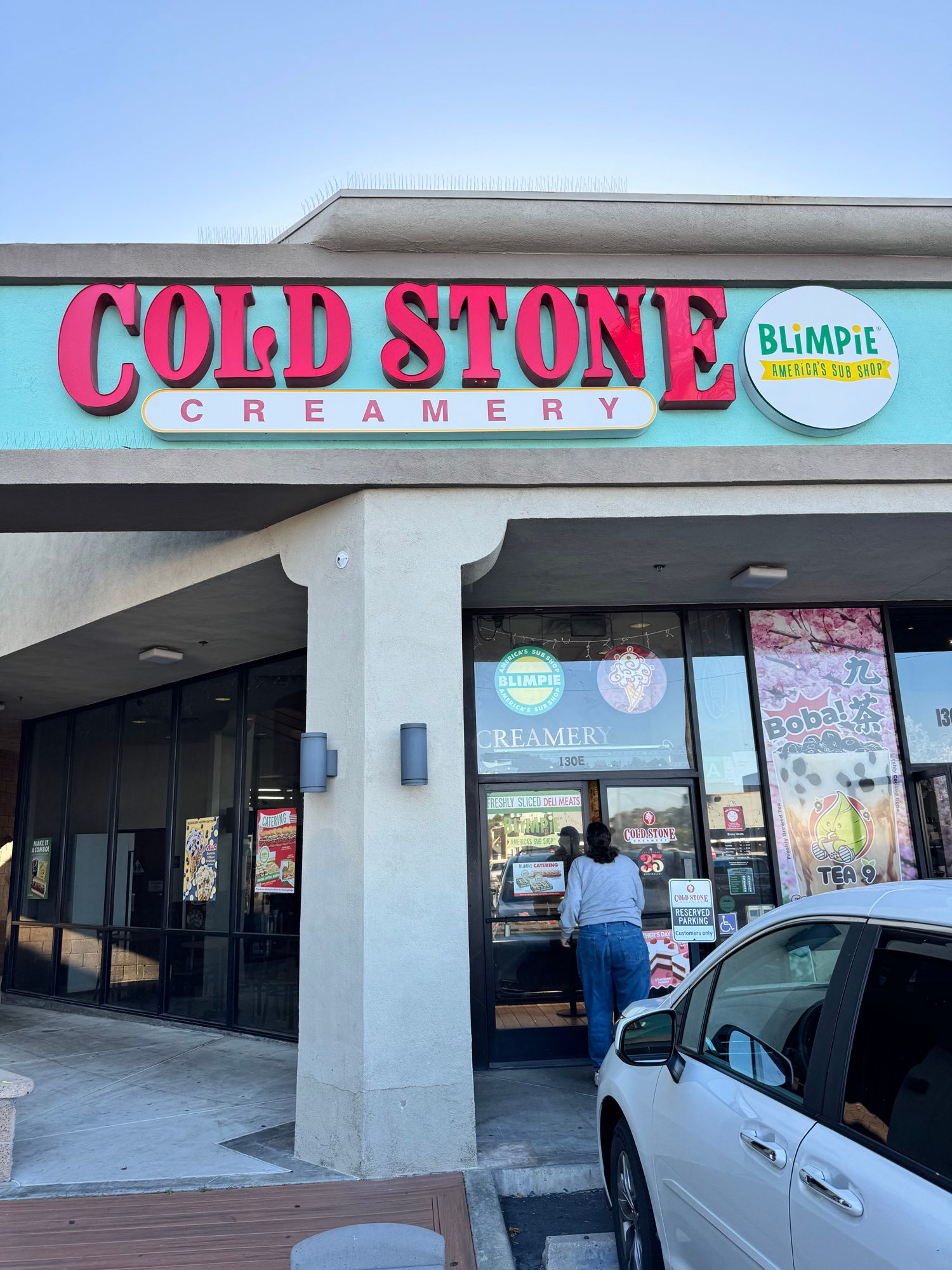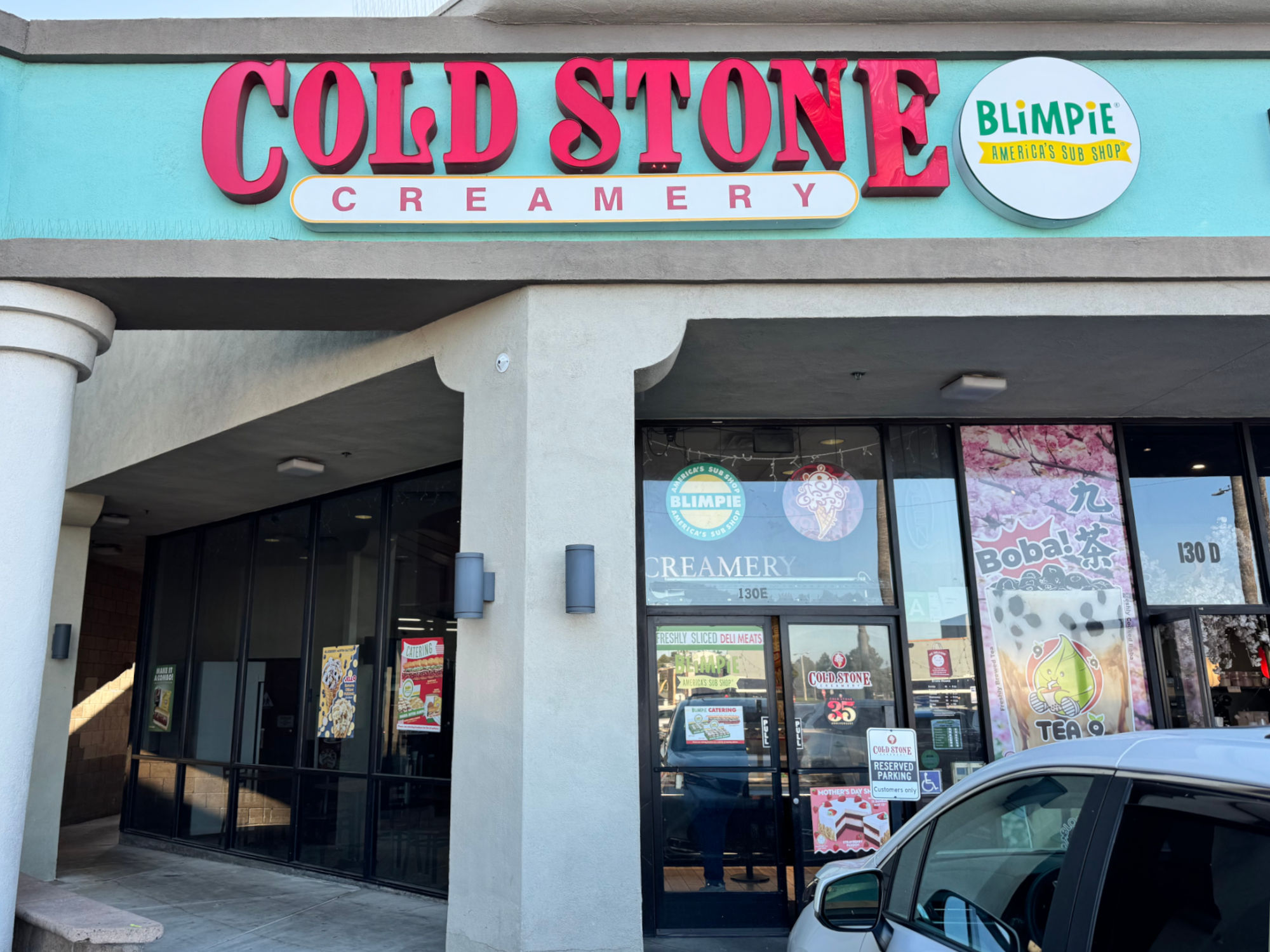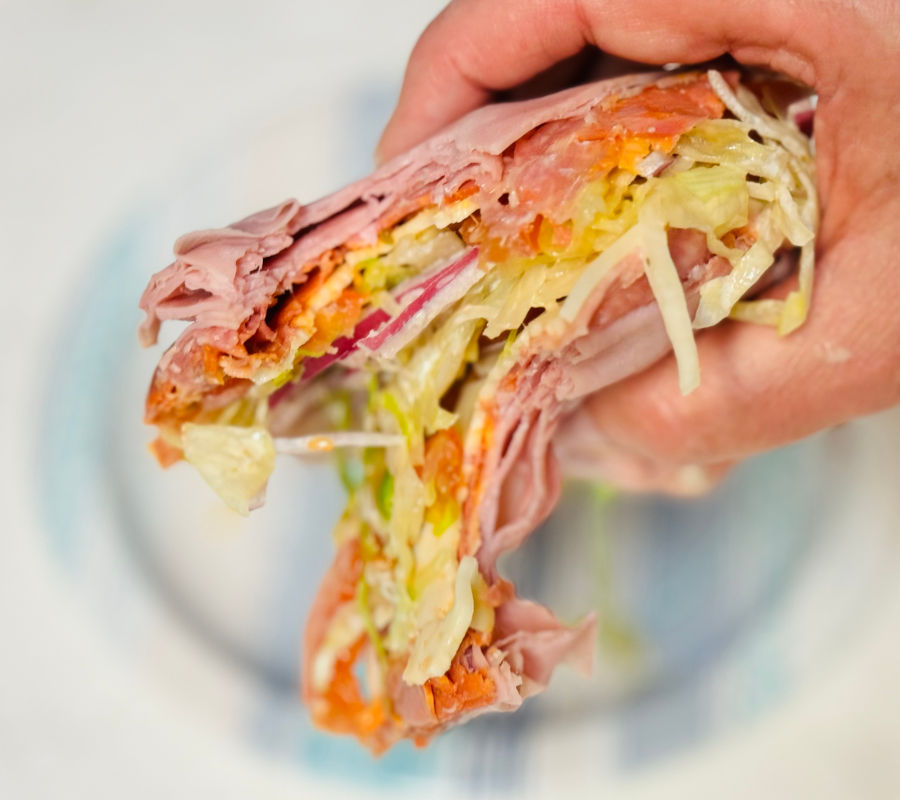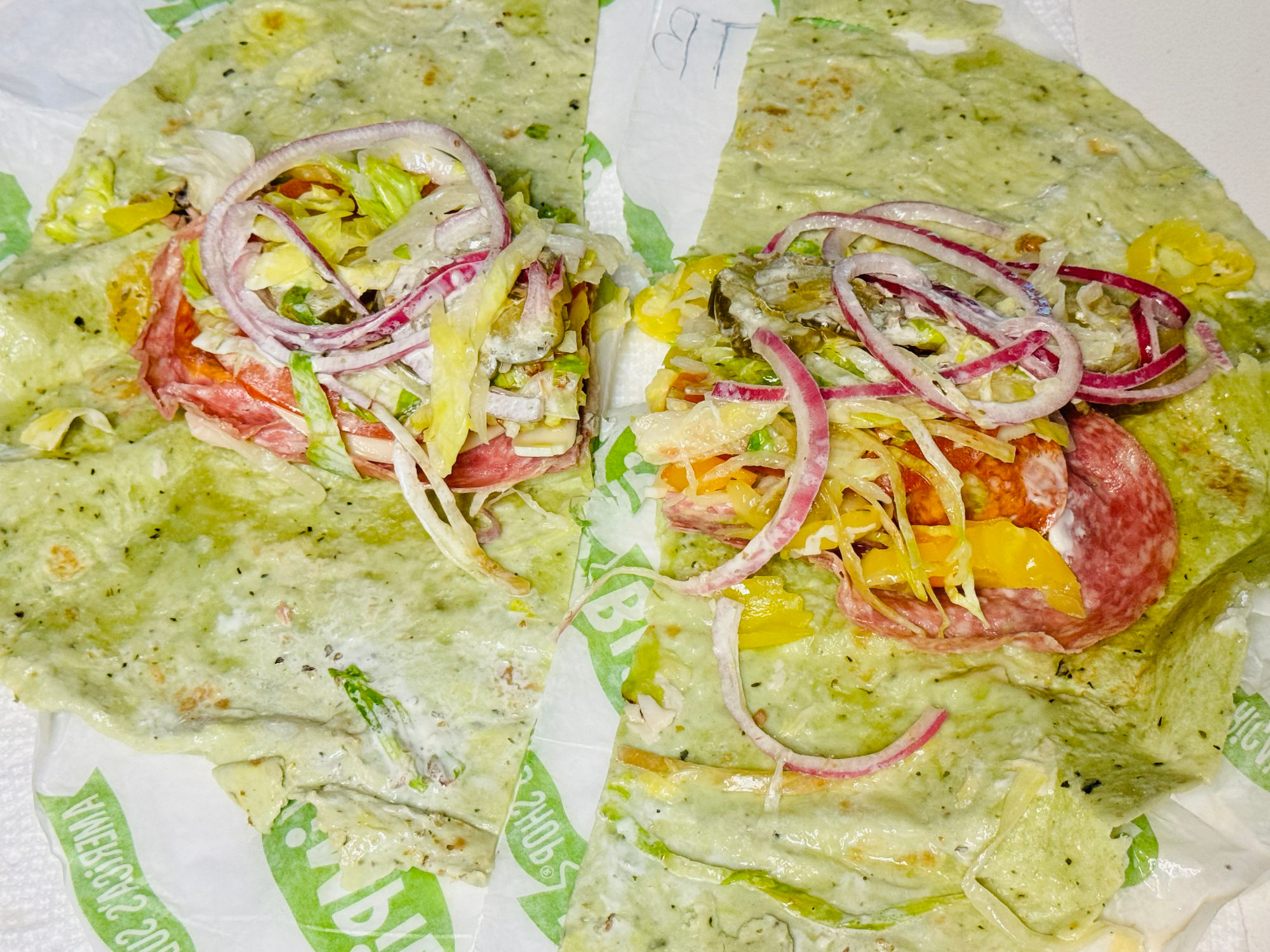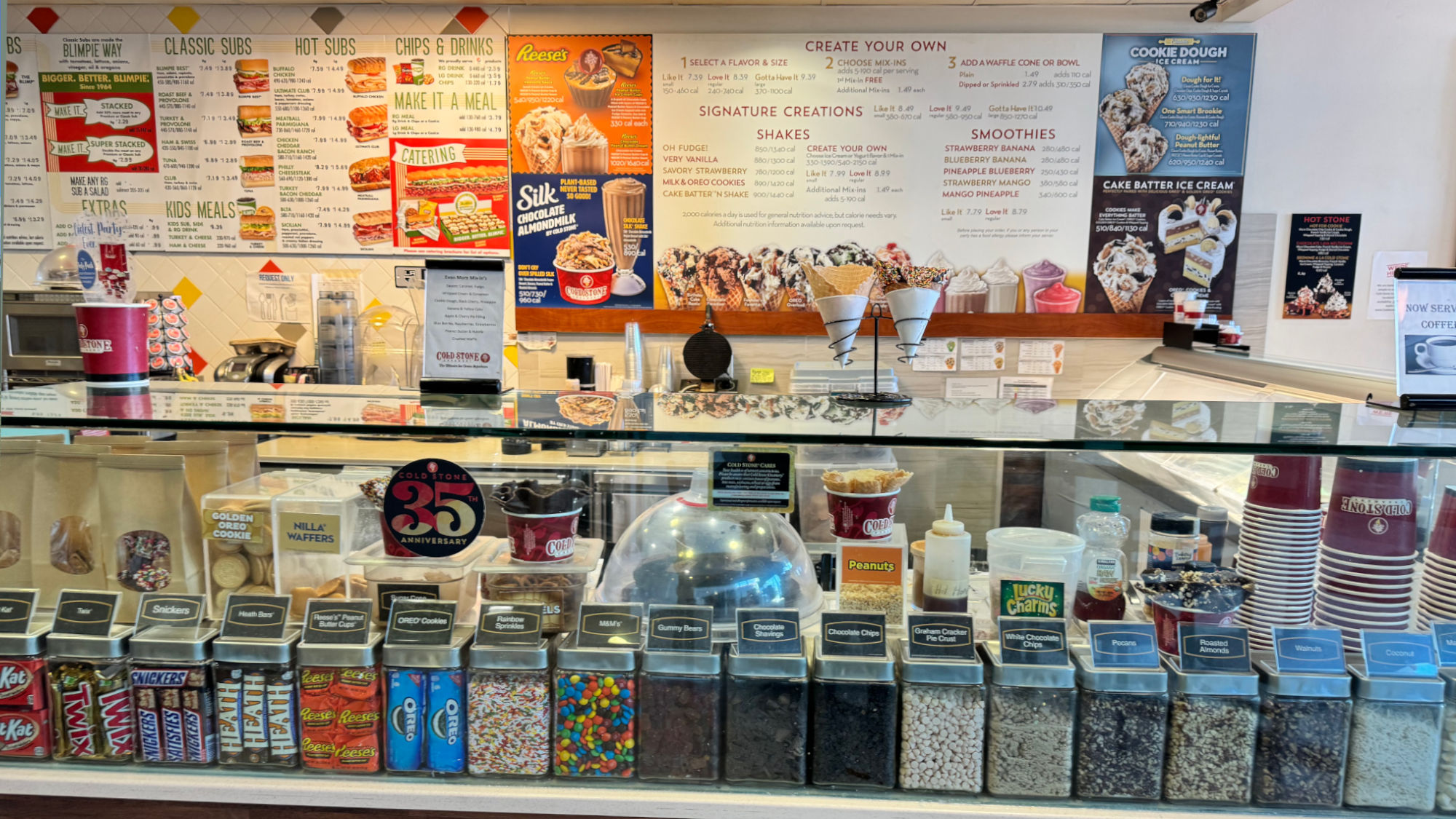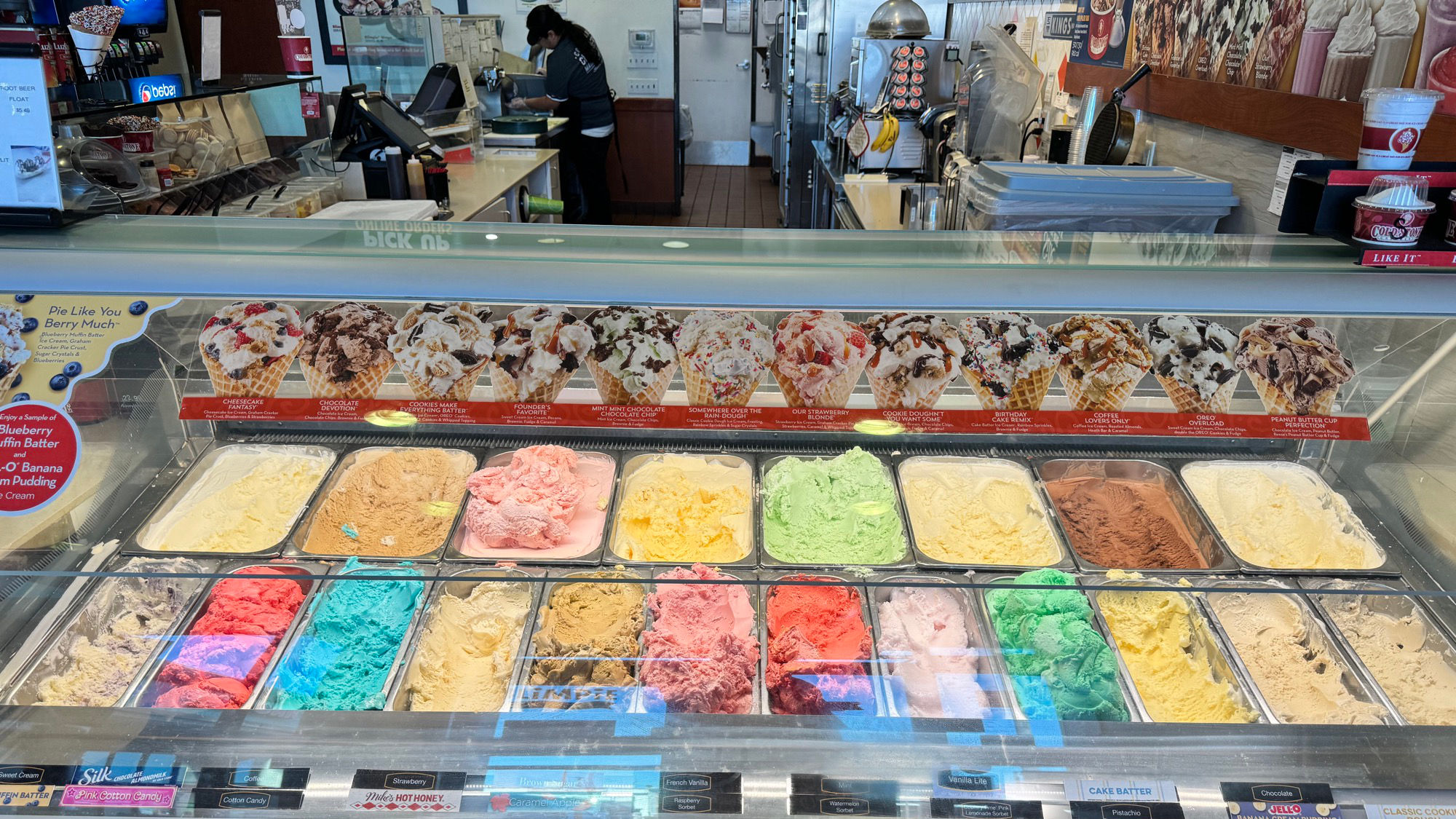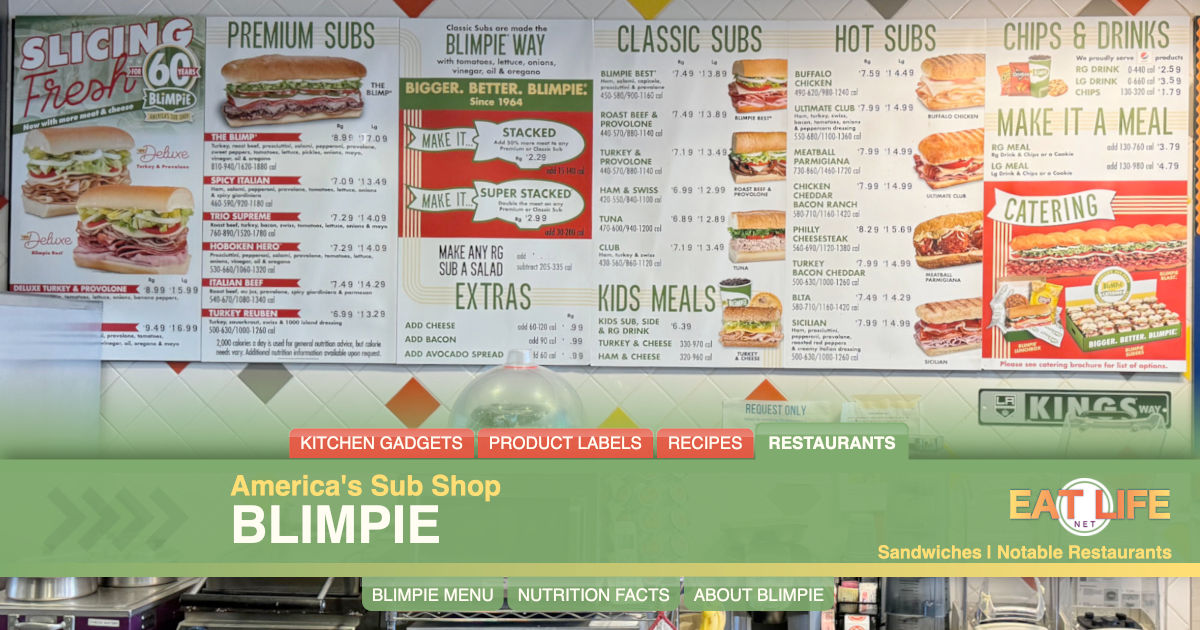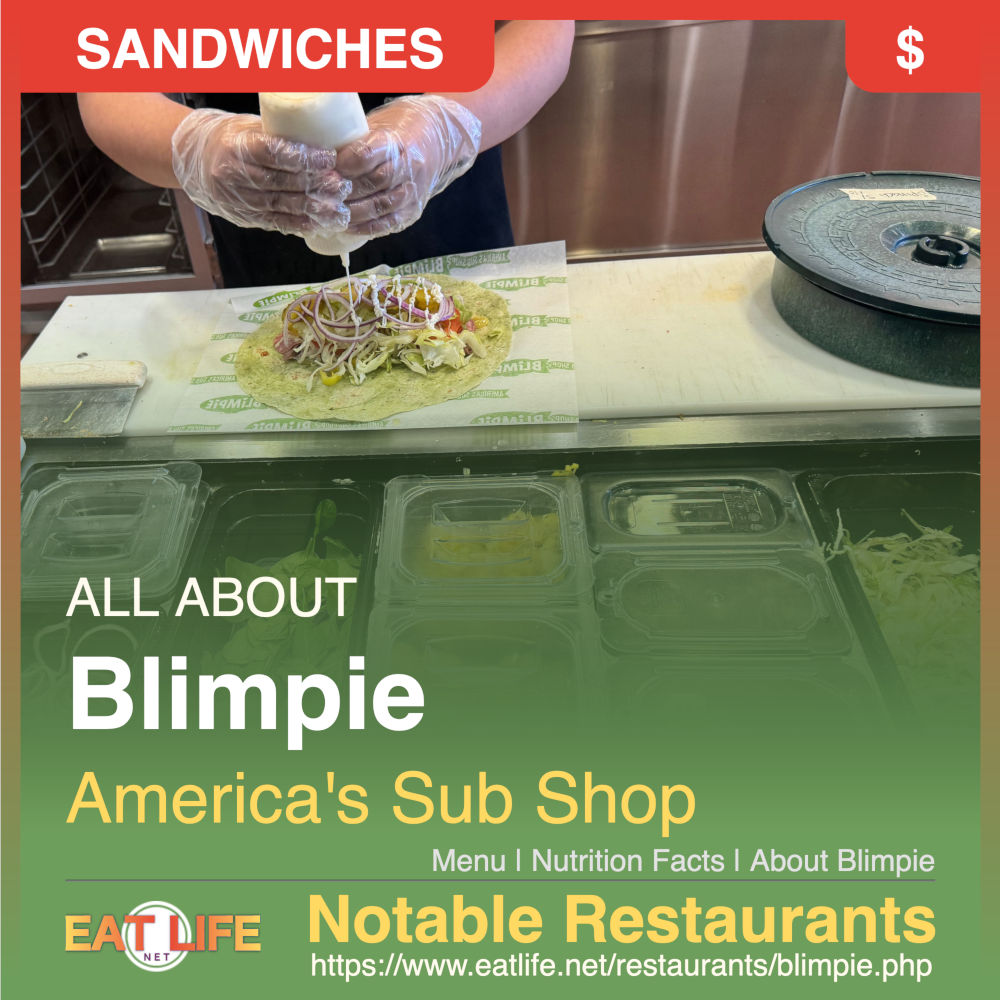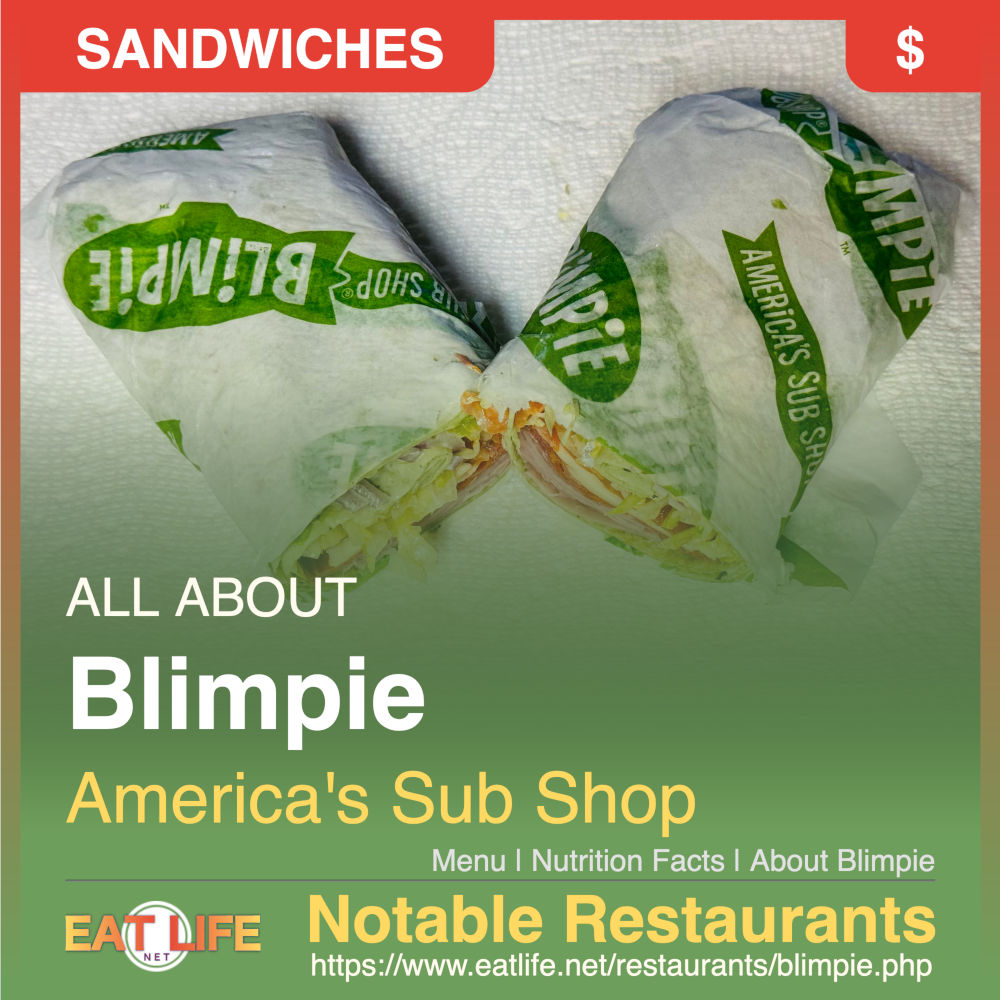The store's name came about because Tony Conza preferred not to call the sandwiches subs, which he felt sounded like a greasy spoon. Conza preferred the term hoagies, but Hoboken residents were unfamiliar with the Philadelphia term. He scanned a dictionary until he found Blimp, a word that sounded to him most like a sandwich.
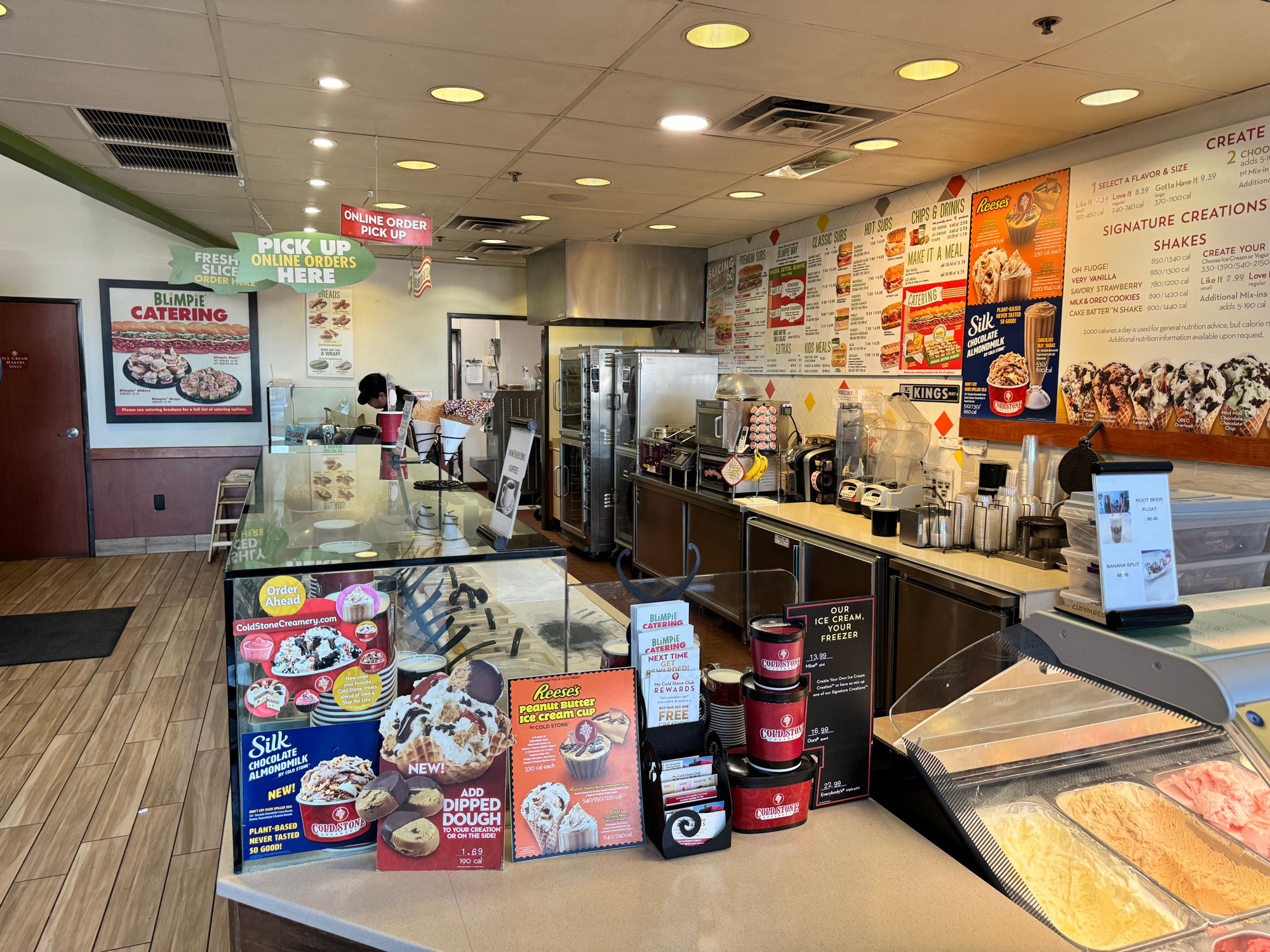
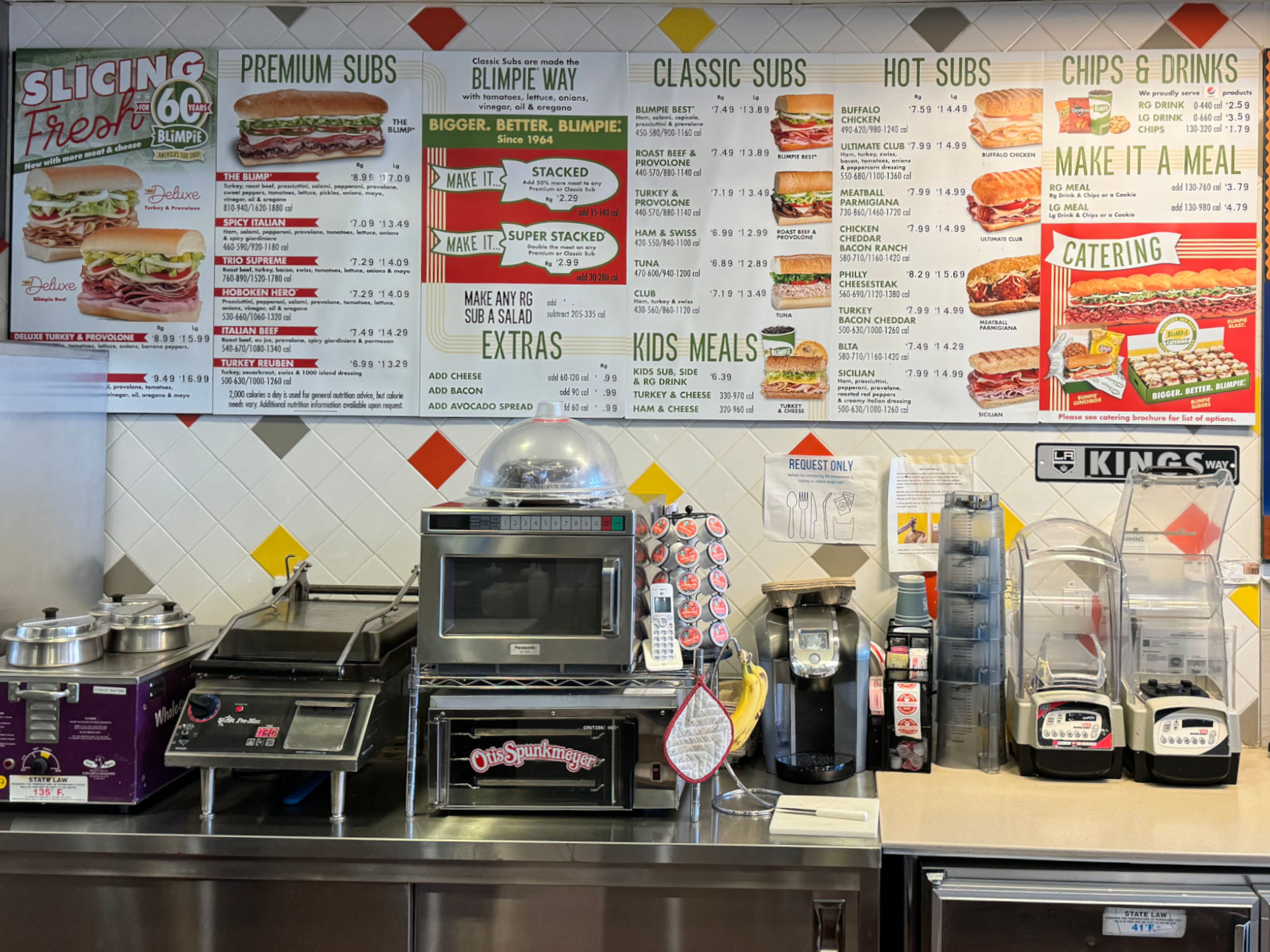
- Premium Subs
- The Blimp
- Spicy Italian
- Trio Supreme
- Hoboken Hearo
- Italian Beef
- Turkey Reuben
- Extras
- Stacked
- Super Stacked
- Make Sub a Salad
- Cheese
- Bacon
- Avocado
- Classic Subs
Made the Blimpie Way with tomatoes, lettuce, onions, vinegar, oil & oregano- Blimpie Best
- Roast Beef & Provolone
- Turkey & Provolone
- Ham & Swiss
- Tuna
- Club
- Kids Meals
- Turkey & Cheese
- Ham & Cheese
- Hot Subs
- Buffalo Chicken
- Ultimate Club
- Meatball Parmigiana
- Chicken Cheddar Bacon Ranch
- Philly Cheesesteak
- Turkey Bacon Cheddar
- BLTA
- Sicilian
- Chips & Drinks
- Make it a Meal
- Catering
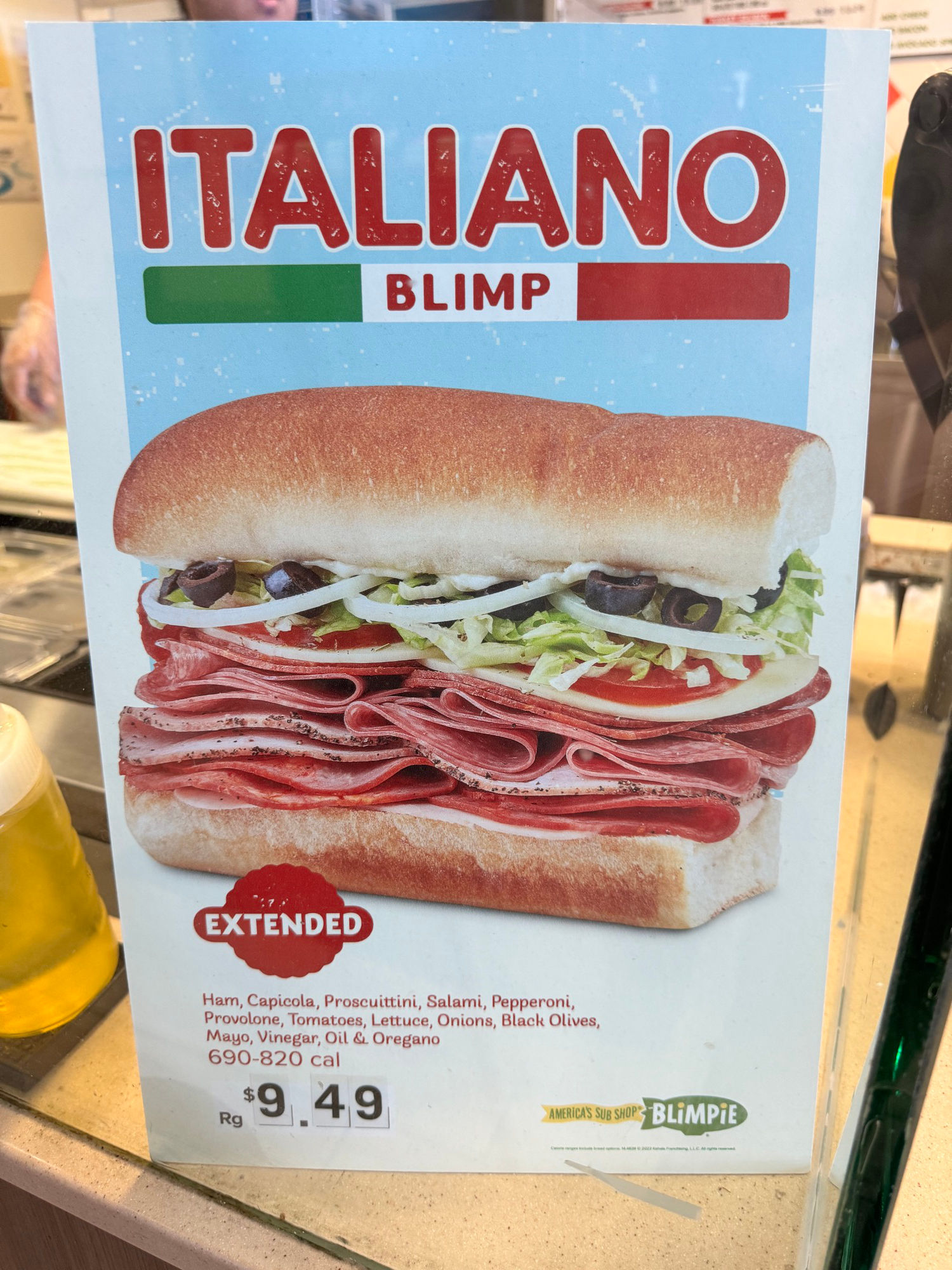
- Ham
- Capicola
- Proscuittini
- Salami
- Pepperoni
- Provolone
- Tomatoes
- Lettuce
- Onions
- Black Olives
- Mayo
- Vinegar
- Oil
- Oregano
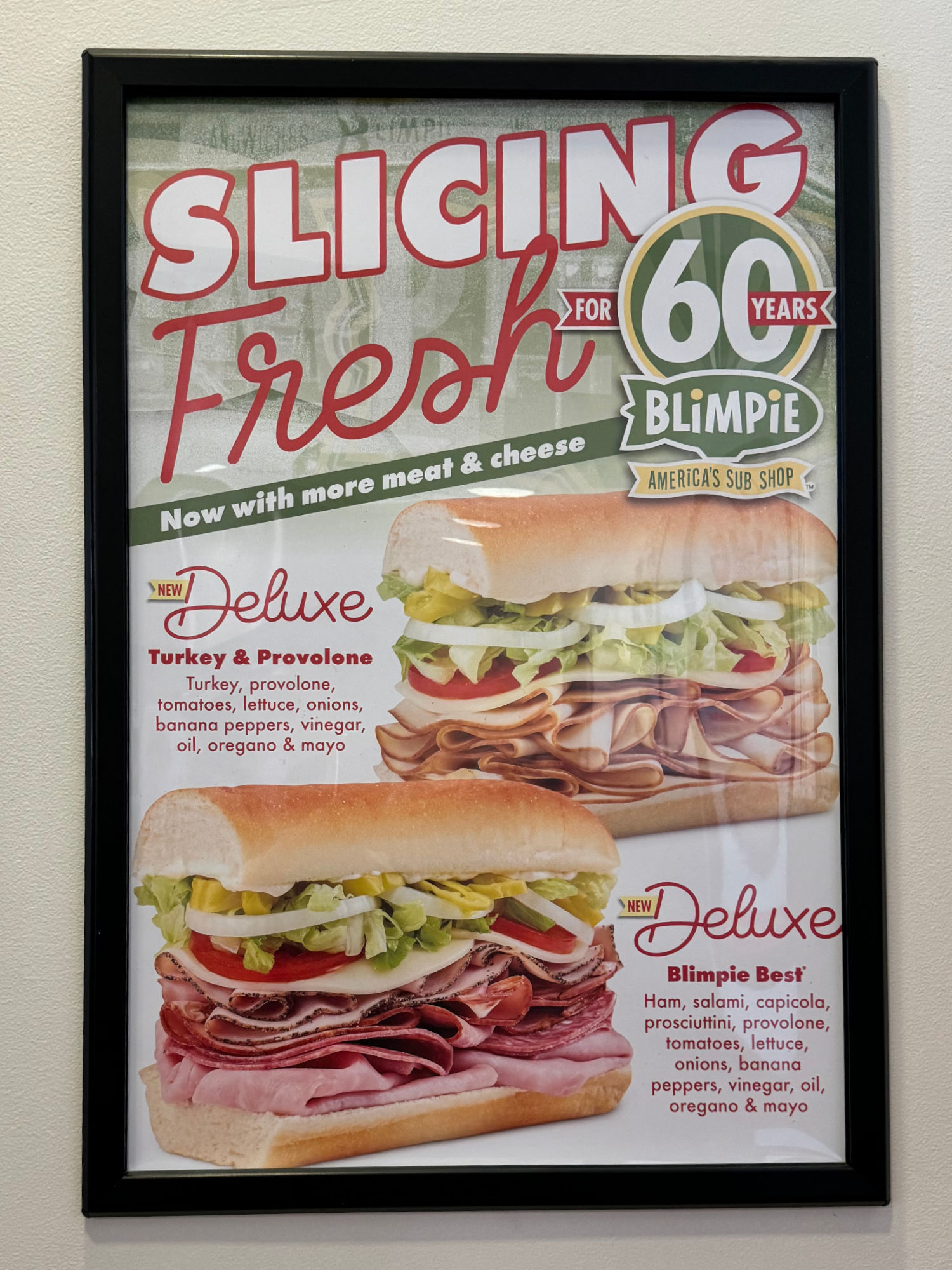
For 60 Years
Now with more meat & Cheese Deluxe Turkey & Provolone
- Turkey
- Provolone
- Tomatoes
- Lettuce
- Onions
- Banana Peppers
- Vinegar
- Oil
- Oregano
- Mayo
- Ham
- Salami
- Capicola
- Prosciuttini
- Provolone
- Tomatoes
- Lettuce
- Onions
- Banana Peppers
- Vinegar
- Oil
- Oregano
- Mayo

- Blimpie Blast
- Blimpie Sliders
- Blimpie Wraps
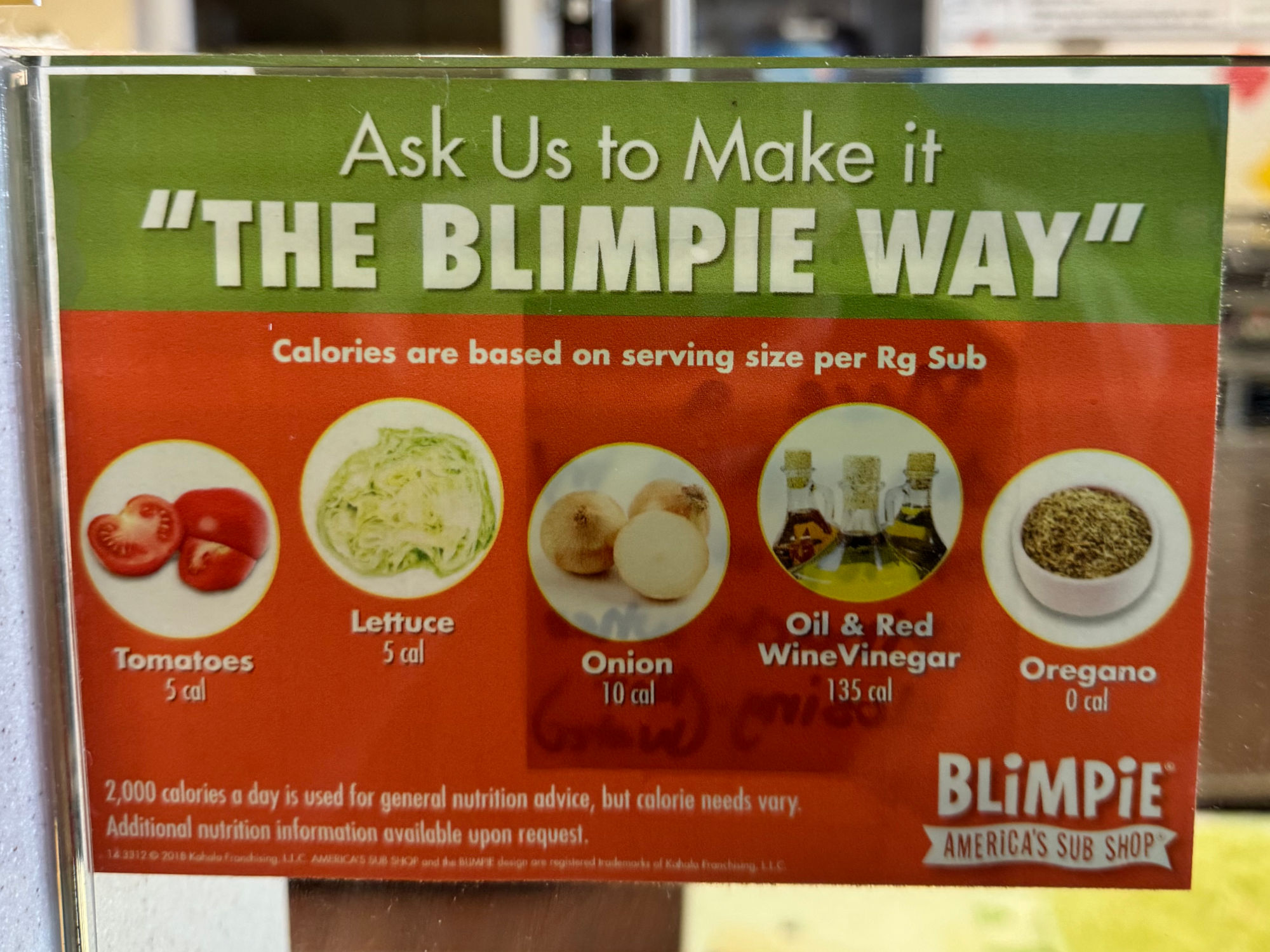
The Blimpie Way
- Tomatoes
- Lettuce
- Onion
- Oil & Red Wine Vinegar
- Oregano
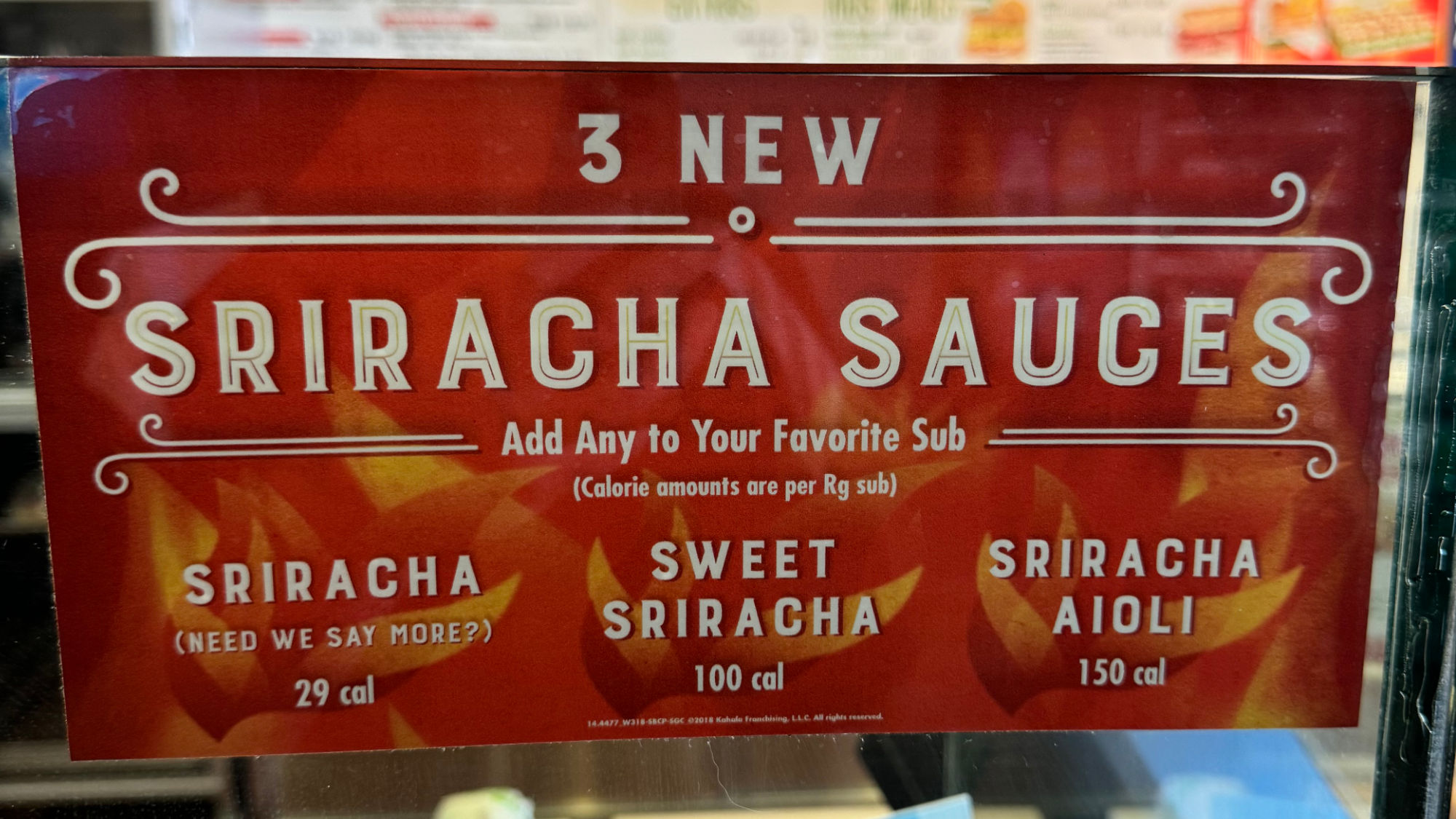
- Sriracha
- Sweet Sriracha
- Sriracha Aioli

Menu Ingredients:
https://www.blimpie.com/assets/Ingredient-Statement.pdf
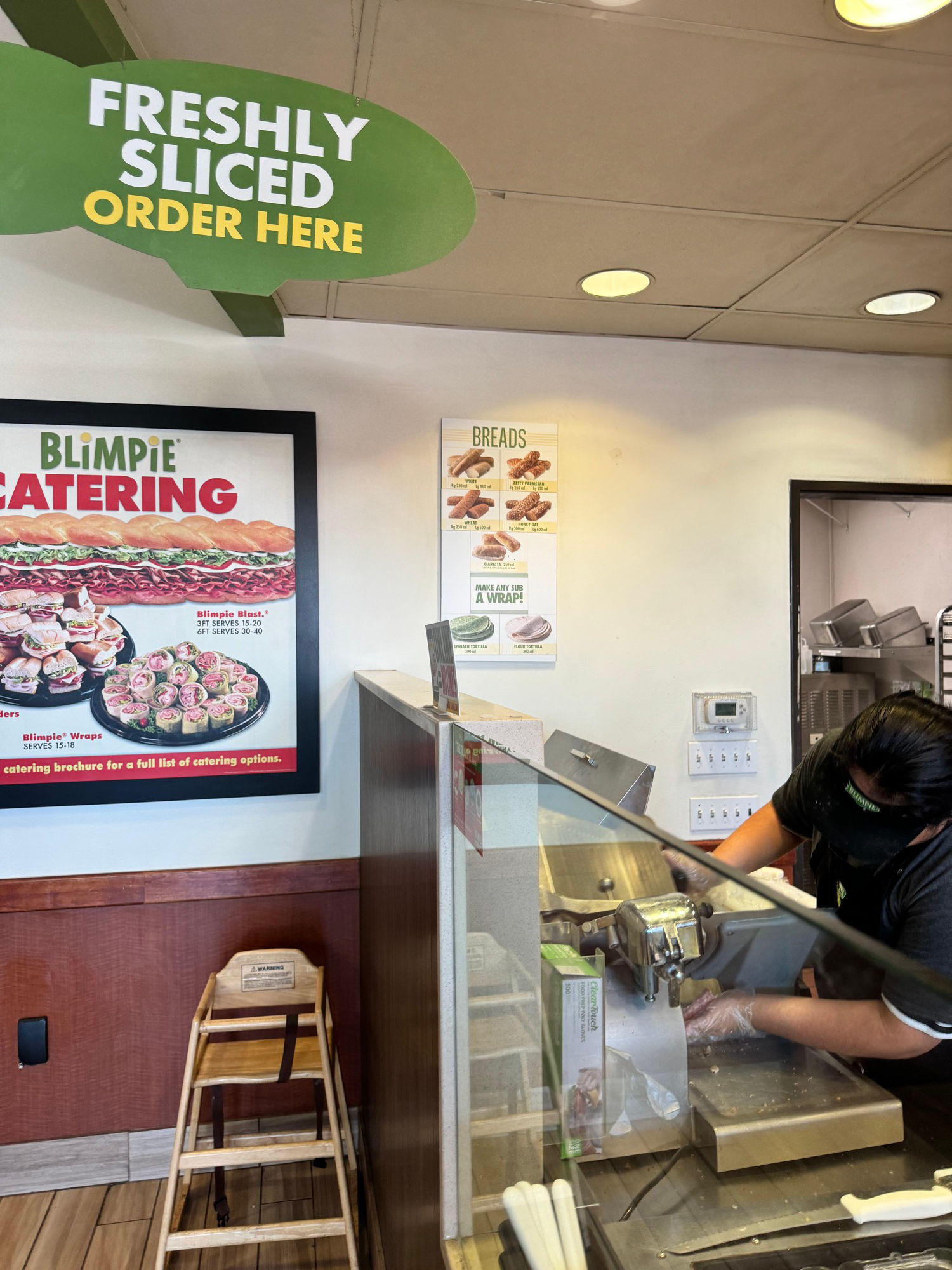
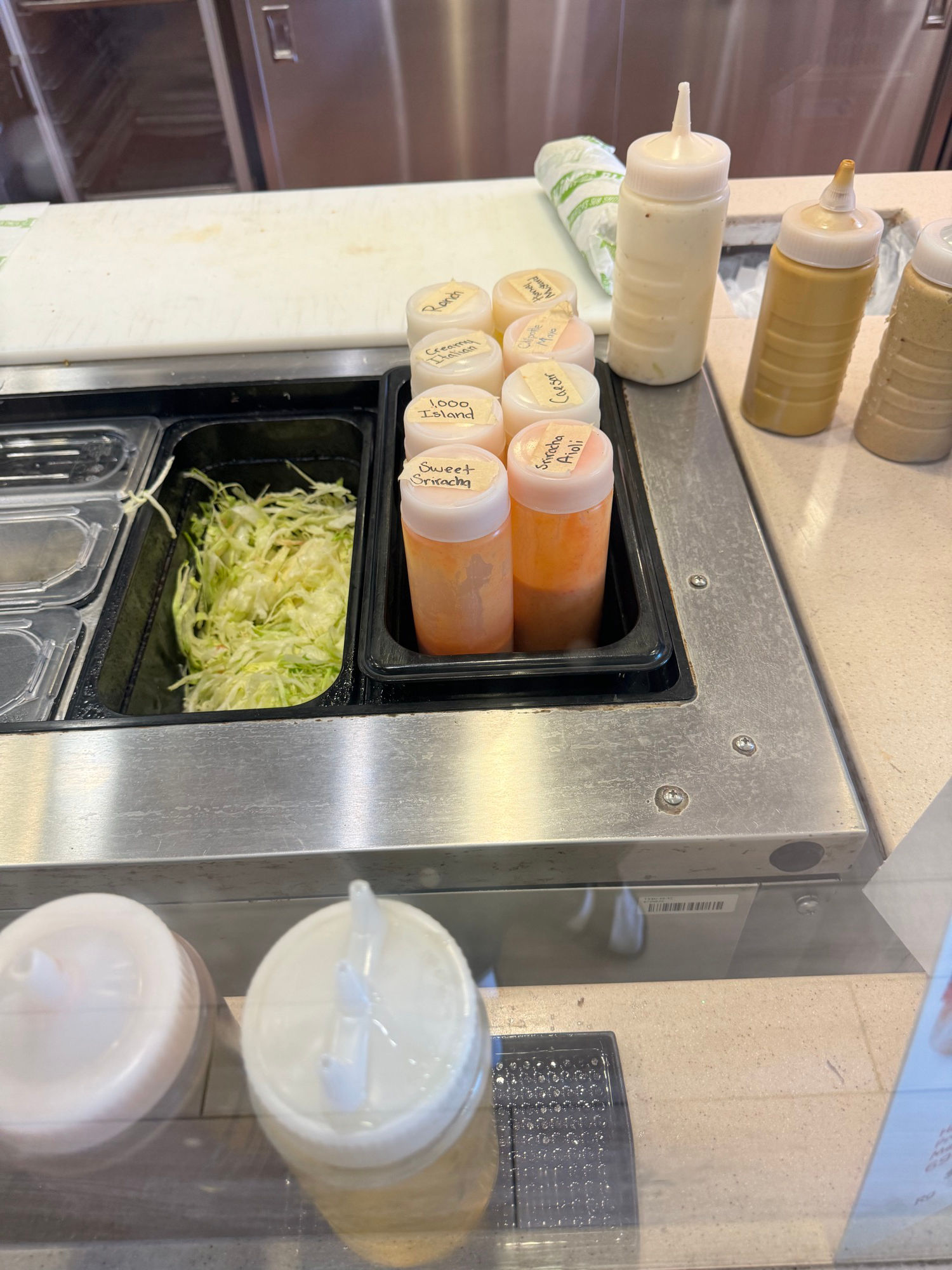
- Ranch
- Honey Mustard
- Creamy Italian
- Chipotle Mayo
- 1000 Island
- Caesar
- Sweet Sriracha
- Sriracha Aioli
- Red Wine Vinegar
- Oil

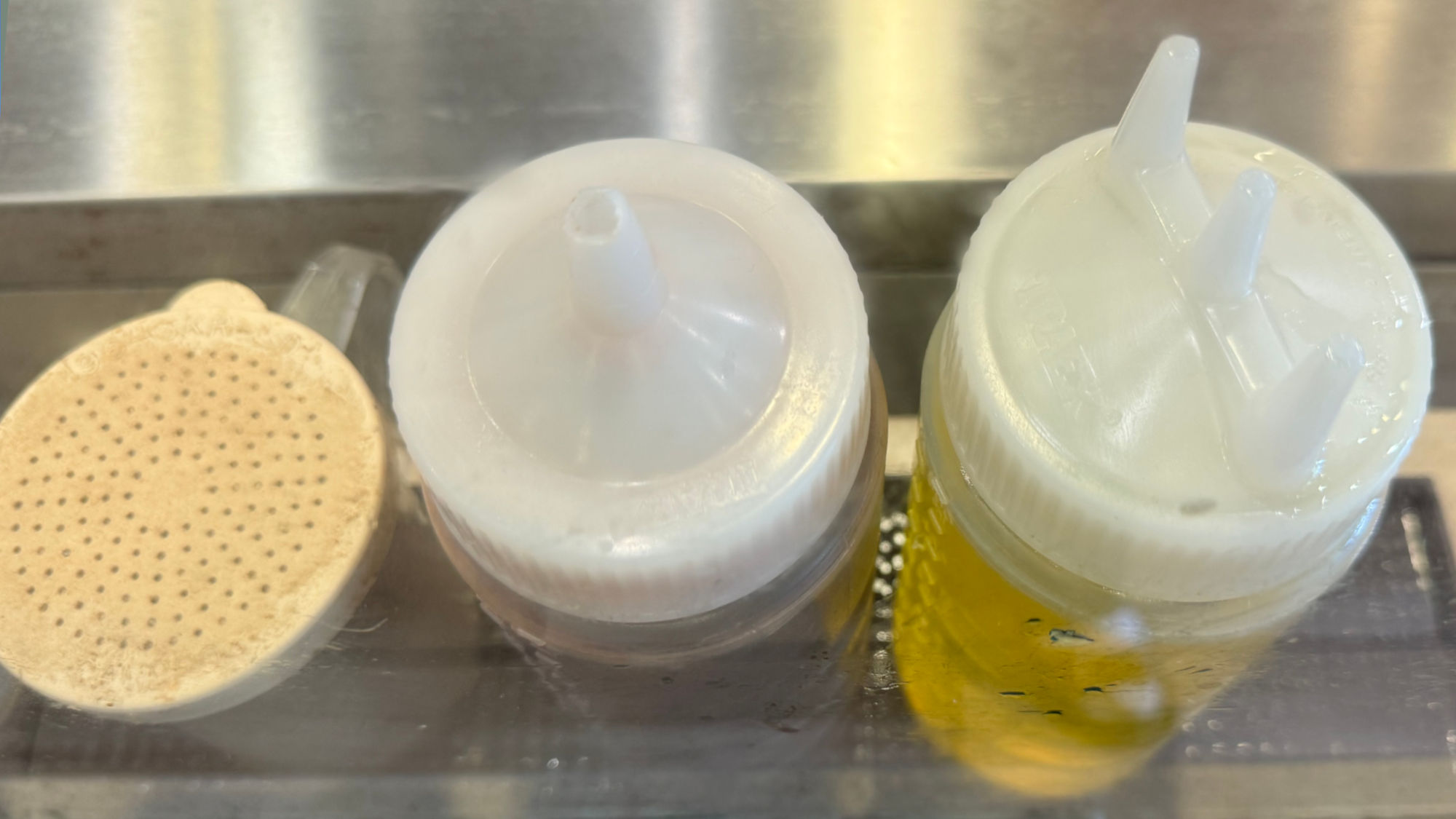
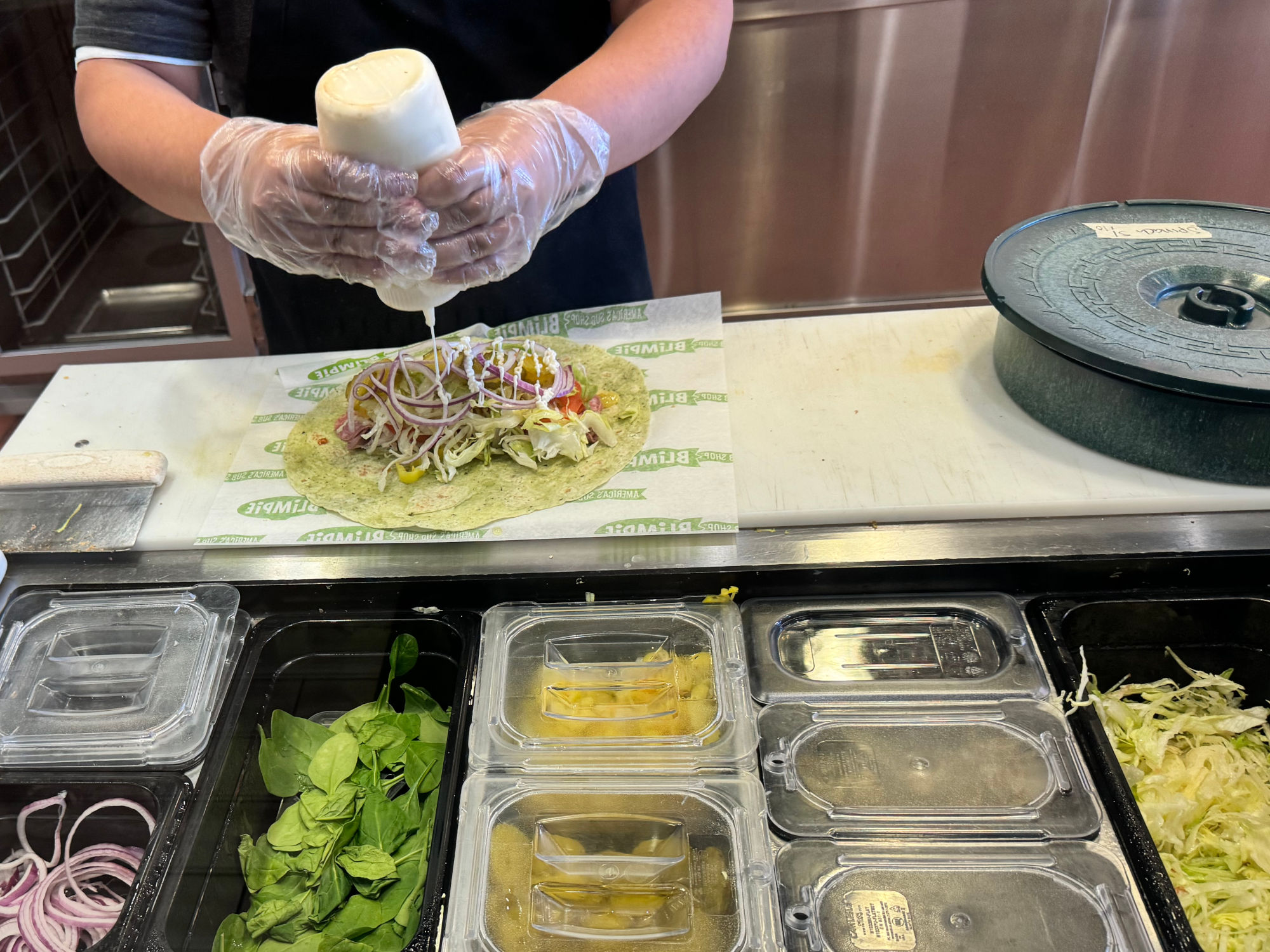
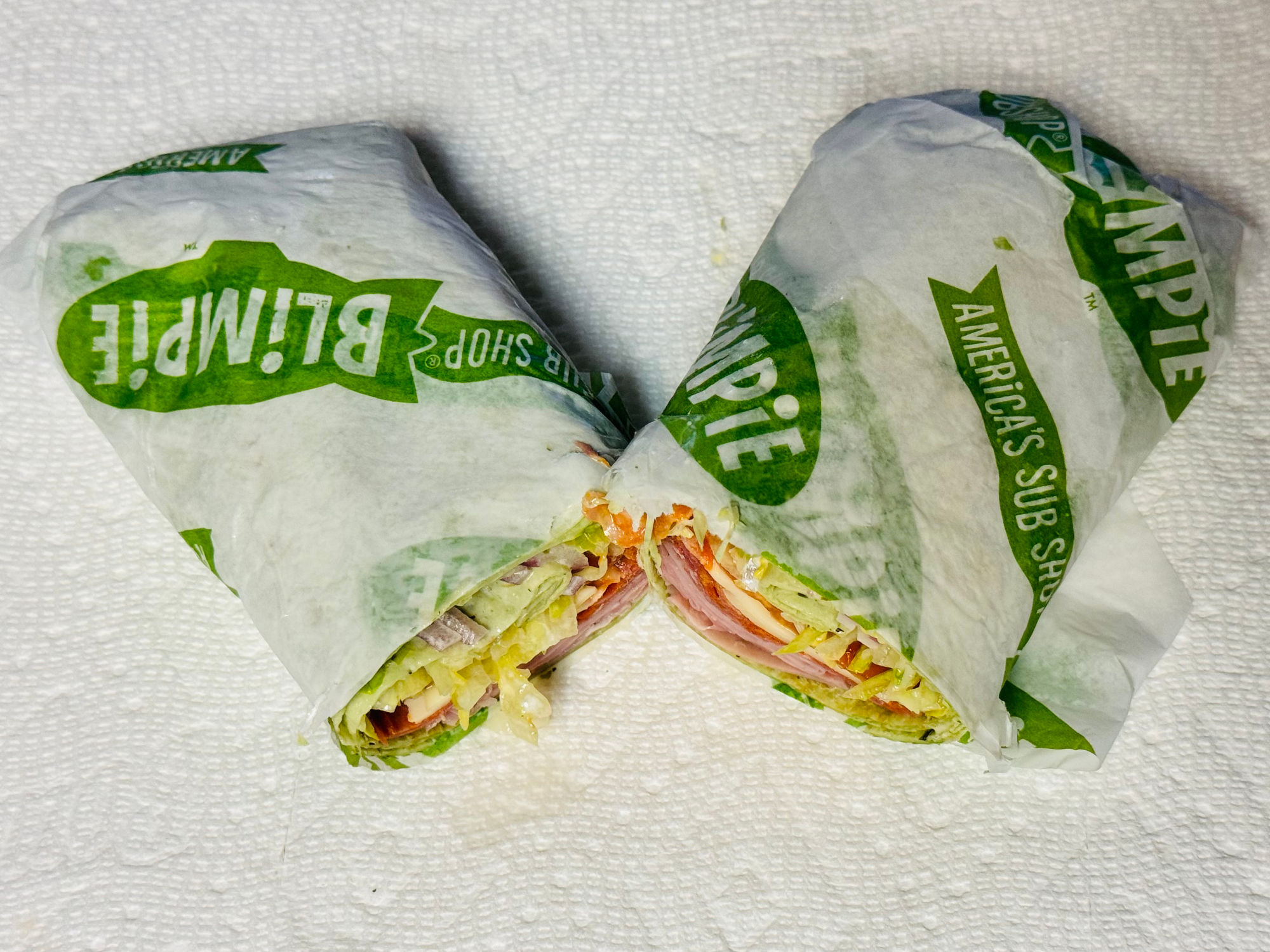
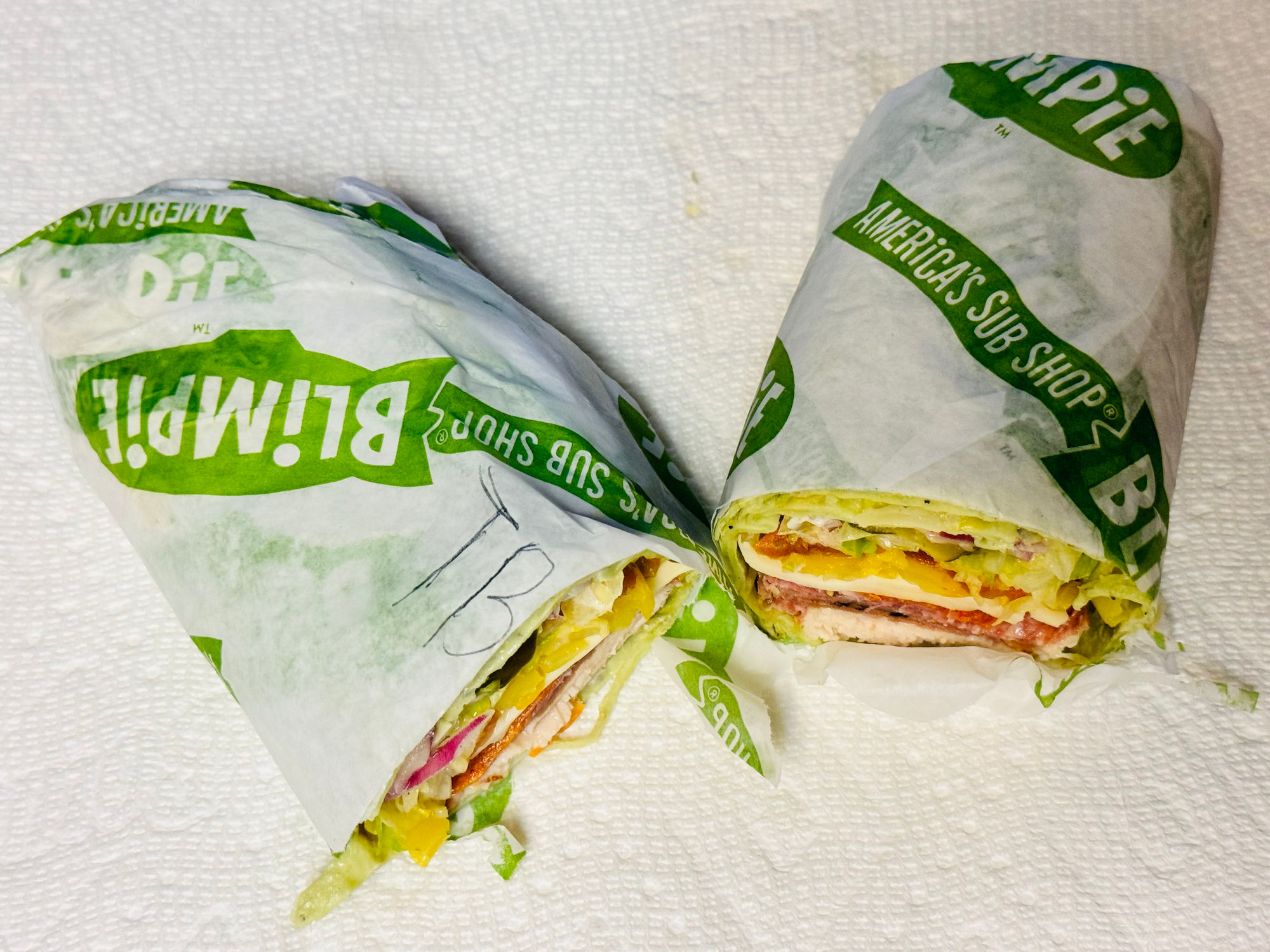
BlimpieAmerica's Sub Shop
Blimpie has been your neighborhood deli destination for more than five decades. With locations coast to coast, Blimpie is proud to continue serving freshly sliced meats and high quality ingredients. We are proud of our history and we're honored to make our subs bigger and better, that's the Blimpie way. Thank you for making Blimpie a part of your lunch and life. Blimpie is America's Sub Shop. Don't you forget it!It was 1964, Beatles Mania was in full swing, the Beehive was the buzzed about hairstyle of choice and Muhammad Ali was the Heavy Weight Champion of the World. It was also the year that Blimpie was born! Three buddies from Hoboken, New Jersey, had a fresh and delicious idea along with a passion to share this idea with the world. They knew the sandwiches they made were the best tasting, with the freshest ingredients all at a great value.
The friends had the passion and the crave-able product, now they just needed the best name ever for their freshly sliced idea. They wouldn't settle for “Subs” or “Hoagies”, their sandwich deserved better. They went through a dictionary for their “name-spiration”. They saw an image of a blimp and thought it resembled their bigger and better sandwich. Drum roll, please... Blimpie was born! On April 4th, 1964, more than 50 years ago, the first Blimpie store opened and the rest, as they say, is history.
BLIMPIE: TIMELINE 1964 Blimpie was Founded in Hoboken, New Jersey
Tony Conza and two school buddies borrow $2,000 and open the first Blimpie in Hoboken, New Jersey. The birth of the best tasting sub.1970 Blimpie Launches First TV Campaign!
Our debut on the small screen. Blimpie subs are always ready for their close-up.1984 Blimpie Best was Created
The Blimpie Best remains our #1 seller. We know... we know... You're welcome.1995 Blimpie Goes International
Blimpie goes International. The world now knows what we've known for years, Blimpie is delicious, in multiple languages.Blimpie opens it's 1,000th location!
The 1,000th Blimpie location opened. One thousand reasons that Blimpie is the best.2009 Pretzel Bread in the House!
Pretzel Bread is in the house! Blimpie was a first to bring this salty, fluffy bread into your stomachs. Knot your average sub! Sorry, we couldn't help ourselves.2014 Blimpie Celebrates 50th Birthday!
Blimpie celebrated our 50th birthday! Thanks for the applause, we know we're golden. We look forward to another 50 years of excellent customer service and fresh-sliced subs.The Hoboken Hero was Introduced
A way to thank our loyal customers with a new take on an Italian classic. Can we hear a yum up in here?
- Slicing Fresh Since 1964
- Bigger. Better. Blimpie.
WIKIPEDIABlimpie International, Inc
American submarine sandwich chain based in Scottsdale, Arizona. It was founded in Hoboken, New Jersey, in 1964, by three friends, and has since endured three ownership changes.The first Blimpie sub shop was opened on May 16, 1964, in Hoboken by Tony Conza, Peter DeCarlo, and Angelo Baldassare, former high school friends and classmates at Saint Peter's Prep in Jersey City. Inspired by the successful Point Pleasant operation Mike's Submarines (later Jersey Mike's Subs), the three speculated that a similar restaurant would do well in Hoboken.
BlimpieThe store's name came about because Tony Conza preferred not to call the sandwiches subs, which he felt sounded like a greasy spoon. Conza preferred the term hoagies, but Hoboken residents were unfamiliar with the Philadelphia term. He scanned a dictionary until he found "Blimp", a word that sounded to him most like a sandwich.By the beginning of 1992, there were Blimpie restaurants in 27 states. That year, the chain passed the 500-unit mark and the company changed its name to Blimpie International, Inc.
- In the spring of 1993, Blimpie began trading its stock on the NASDAQ exchange.
- By autumn of 1993, the chain had 670 outlets.
- As the 1990s continued, Blimpie devised a new concept that aimed to grow the company even more. Blimpie's franchises began appearing in nontraditional locations. First was convenience stores; as convenience store proprietors began to seek ways to compensate for declining cigarette sales, they turned to fast food. Blimpie's was appealing for many, mainly for two reasons: a real kitchen was not required, and startup costs were relatively low compared with other fast-food operations.
- In 1995 they passed the 1,000 outlet mark.
- By 2011, the number of Blimpie locations had fallen to 739 stores.
Mental FlossAmerica's oldest submarine sandwich chain
Blimpie has served up deli subs for over 50 years. And though they started off with just signature subs-like their meat-packed Blimpie Best, which has been a best seller ever since it was added to the menu in 1984-Blimpie has franchised locations in shopping malls, convenience stores, sports arenas, and hospitals that offer everything from paninis to salads.
- Three 24-year-old friends started Blimpie in 1964
Tony Conza, Peter DeCarlo, and Angelo Bandassare met at their Jersey City high school, Saint Peter's Prep, and the three friends thought that Hoboken needed a submarine sandwich shop. After borrowing $2000 from a businessman friend, they opened the first Blimpie store in Hoboken, N.J. on May 16, 1964.- Blimpie got its unusual name thanks to the dictionary
Conza and his friends didn't want to name their shop after subs or hoagies, the generic terms for sandwiches. Instead, Conza looked through a dictionary starting with "A," and realized that the word "blimp" visually represented the shape and large size of his sandwiches.- The friends went their separate ways, resulting in two distinct Blimpie companies
In 1965, Bandassare decided to leave Blimpie, but Conza and DeCarlo continued on without him, selling Blimpie franchises in the northeast and mid-Atlantic. In 1976, Conza wanted to expand into the South, but DeCarlo didn't. The two friends decided to split their company in two, with Conza in charge of the original Blimpie company and DeCarlo in control of a new company, called Metropolitan Blimpie.- Conza's failed southwestern restaurants damaged Blimpie's business
In the early 1980s, Conza decided to diversify his company. In 1984, he opened Border Cafe, a restaurant serving Mexican food and drinks in Manhattan. In 1986, he opened two more Border Cafes in New York but lost a lot of money. Conza later admitted that Border Cafe was a huge mistake since he spent less time, energy, and money on Blimpie. During this time, Blimpie competitor Subway expanded across the country, leaving Blimpie on seriously shaky financial ground.- Blimpie battled with Subway to be the top sub chain
In 1988, Conza closed the Border Cafe restaurants, focusing all his energies on Blimpie. He admitted that Subway did an effective job introducing Americans to submarine sandwiches, but he set a goal to get Blimpie sandwiches into the mouths of more people. Blimpie introduced lower calorie menu offerings, including tuna, turkey, crab, and gourmet salads. Conza's strategy worked, and Blimpie's sales were up.- The "Simply Blimpie" advertising campaign was a fun tongue twister
In 1993, Blimpie had 670 locations and was a publicly traded company on NASDAQ. Blimpie focused on marketing and advertising as a way to increase the percentage of new franchises that were successful. The "Simply Blimpie for fresh-sliced subs" tag line appeared on TV, radio, and print commercials, and the chain got plenty of screen-time and mentions on network and quiz shows as well.- Diminishing cigarette sales meant increased business for Blimpie
Because less people were buying cigarettes, convenience stores needed an alternative way to make money. So, by the mid-1990s, Blimpie franchises began opening inside of convenience stores. Blimpie had low startup costs and didn't require a fully equipped kitchen, which made it an attractive fast-food option for convenience stores. The chain also opened in other nontraditional venues like hospitals, college campuses, and sports stadiums, and customers could buy Blimpie sandwiches from vending machines. In 1995, Blimpie had more than 1000 locations.- In the late 1990s, Blimpie expanded with Hawaiian tacos, smoothies, and pasta
In the late 1990s, Blimpie International, Inc. diversified and expanded with the addition of Maui Tacos, Smoothie Island, and Pasta Central. In 1997, Blimpie acquired a controlling stake in Maui Tacos, a fast-food chain in Hawaii that served a fusion of Mexican and Hawaiian food. Blimpie opened Maui Tacos locations in the continental U.S., and started Smoothie Island, a Maui Tacos offshoot, in 1998. The next year, Blimpie opened Pasta Central, a co-branded restaurant that allowed Blimpie to make money selling pasta and pizza for dinner.- In the past 15 years, Blimpie has closed stores and changed ownership
In 2001, Blimpie was losing revenue and needed to make a change. A private investment group bought Blimpie for $25.7 million, and Conza stepped down from his CEO duties, becoming an advisor in 2002. Another shift occurred in 2006 when a franchising company called Kahala Corp. bought Blimpie. In the decade between 2001 and 2011, Blimpie struggled as it closed over a thousand stores, and its sales went down by more than 60 percent.- In 2014, Blimpie celebrated its 50-year anniversary with 50-cent subs
Despite the store closures, Blimpie celebrated its 50th anniversary in 2014, offering 50-cent subs at all locations to the first few hundred customers. The Jersey City, New Jersey Blimpie store made a 50-foot sandwich, donating all proceeds to a local chapter of Boys & Girls Club of America. The mayor of Jersey City was also on hand to present Conza with a proclamation celebrating Blimpie's 50 years in business.
MashedAmerica's Sub Shop
Throughout its seesaw history, Blimpie tells an exciting story of how it's survived many dark nights of the soul and has emerged a resilient company. Nearly 60 years on, Blimpie continues to fight the downdrafts in an effort to remain true to its tagline as "America's Sub Shop."The first Blimpie was launched in Hoboken, N.J.
Blimpie began its journey on the Jersey side of the Hudson River when 3 high school pals teamed up after graduation to develop it with $2,500 in funding, They opened the first Blimpie at the corner of Seventh and Washington Streets in Hoboken, N.J., according to NJ.com.The year was 1964, and Blimpie didn't want to sound like just another submarine sandwich company - a factor that factored into its name. Scouring a dictionary, Blimpie's young brain trust was quickly drawn to the word '"blimp" and the accompanying picture that they felt resembled the bread of a submarine sandwich (per QSR).
The ship-to-sub comparison was apt enough for founders Tony Conza, Peter DeCarlo, and Angelo Baldassare, who approved a name that would see the company long past its first location. That being said, Blimpie's first sandwich shop no longer exists (via HMag).
Blimpie was inspired by the sub shop that would become Jersey Mike's
Blimpie's belief that this concept could work was backed by the success of Mike's Submarines in Point Pleasant, N.J., a place that was typically bursting with patronage. Intrigued by its popularity, Blimpie's founders performed some culinary espionage by eating some of Mike's Subs. Impressed by what they ate, they opened their own sandwich shop in a similar vein. Mimicking their mentor proved a sage choice, as both sandwich chains still exist today. There is one exception, though - Mike's Submarines is now known as Jersey Mike's.To ward off early struggles, two of Blimpie's owners sold all of their franchises
In 1976, Blimpie fractured into two companies
It was decided DeCarlo would run Blimpie Metropolitan and retain control of the majority of Blimpie's New York, New Jersey, and East Coast locations. Conza would head the original company, but renamed it International Blimpie Corporation while crafting a new imprint. Conza relished the opportunity and quickly franchised Blimpies "wherever there was interest," according to the New York Times. Conza would eventually admit the error of his ways, and over the years, many of those locations damaged the brand before closing down. They allegedly drove customers up the wall with filthy bathrooms and discordant employees.Blimpie went public in 1983
Blimpie moved away from subs in the 1980s
If you've ever wondered why Subway is so enormous, a big part of that may be Blimpie's decision to pump the brakes on its best product in the 1980s: the sub sandwich.As Subway made moves in the submarine sandwich sector, Blimpie pivoted toward a sit-down restaurant idea that became the Border Cafe (via the New York Times). It was a short-lived endeavor that hemorrhaged funds shortly after striking ground in Manhattan. Although Border Cafe's initial numbers were promising, not even former New York Yankee great Dave Winfield could save them as a partial owner (via Reference for Business). However, that was the small problem. The big problem? Blimpie gave Subway an inch and it took a mile. It padded a sandwich-selling lead that only grew wider and would never again be threatened by Blimpie.
Today Subway boasts over 40,000 locations (via Statista), while Blimpie taxies at the back of the pack with approximately 156 locations as of this writing (via Blimpie).
Blimpie's CEO once devised a list of "101 Small Improvements"
Blimpie's CEO launched a periodical titled "No Baloney News"
Titled "No Baloney News," Conza's bulletin would finally offer top-down guidance for Blimpie franchisees. It became a resource that was sorely needed as sandwich shops sprawled into reckless territory. Better yet, "No Baloney News" was accompanied by a hotline, if franchisees ever needed a tip or had to relay a frustration from the bottom up.In 1989, Blimpie introduced a reduced calorie menu
Back in the 1980s when fat was declared the enemy of the people, Blimpie took full advantage of the anti-lipid movement with a refreshed menu dubbed "Blimpie Lite."According to Reference for Business, the low-calorie menu carried tuna, crab, chicken, and turkey salads, and those reduced-fat staples were offered on a pita. These seemingly healthier options proved successful and Blimpie's dietary experiments turned greener. A year later, it rolled out gourmet salads under the sub-brand, Blimpie Fresherie. This move led to increased revenue, as Blimipie ascended toward another peak on its company sales graph.
Blimpie doubled its advertising budget in the 1990s
As its budget increased, Blimpie's rate of franchise failure declined by one-third throughout the early 90s. By 1993, Blimpie would be available at 670 locations, and in 1994, its 800th location would open up in the Upper Peninsula of Michigan in the small town of Iron City. It proved that Blimpie was back in a big way, for the time being.Blimpie found quick success franchising at convenience store locations
It appeared in nontraditional locations with either a kitchenless restaurant, or a kiosk that could fit in any space offering 100 square feet.Since the late 1990s, Blimpie has struggled and changed ownership multiple times
Blimpie's hot streak of 90s success would fade in the new millennium, and the hoagie emporium would crash hard. According to USA Today, Blimpie plummeted from 1,853 viable locations and revenue of $300 million in 2001 to just 739 locations and $115 million in revenue by 2011.In the same decade that Blimpie suffered a beatdown, it also found a prime benefactor. Kahala Brands would snag Blimpie in 2006 before rolling up under the conglomerate of MTY Food Group (via The Globe and Mail). So far, MTY Food Group has kept Kahala intact and Blimpie beneath its banner. According to its website, Kahala Brands run deep with Blimpie sitting shotgun, placing the sub shop in league with other tasty destinations such as Pinkberry, Baja Fresh, and Cold Stone Creamery. These are just a few of the companies on its current roster of 29 restaurant chains at the time of this writing.
DistractifyYes, Blimpie Still Exists
However, the chain has massively downscaled over the years. Once boasting nearly 2000 locations in the states, Blimpie currently has fewer than 200 shops left.The reason so many Blimpie locations were shuttered is partially due to Subway's success. But it also has to do with how the chain was managed.
In 1964, Blimpie founder Tony Conza and his two friends Peter DeCarlo and Angelo Bandassare borrowed $2,000 in order to open the first shop. Naturally, Blimpie was a massive success and the locations quickly multiplied. But in 1967, "everything began to veer out of control," according to The New York Times.
The outlet wrote: "Conza and Mr. DeCarlo admitted they weren't skilled businessmen, and they had been incautious about the cost of goods and employee salaries. The sandwich shops were generating ample sales but disappearing profits."
While the chain was able to find quick fixes for many of its obstacles in order to ensure continued growth, it appears that Blimpie's best years pre-date the 2000s. In 2001, the franchise was sold to a private investor group and locations started to disappear.
Kahala Brands, which owns Cold Stone Creamery and Pinkberry, bought Blimpie in 2012 and continues to oversee it today.
MashedWhile many of us haven't seen a Blimpie in years, it turns out that it still exists, but it's struggling to stay afloat. There are so few locations now (often just in gas stations) that it would be easy to think it no longer exists. The truth is that it's been in freefall since the early 2000s. It's still hanging on, and we'd love to see it make a miraculous comeback. However, it will have to overcome a lot of missteps to bounce back to the place it once was.The restaurant is going to have to make some major changes to bring itself from the brink of death. Blimpie has a lot of sub sandwich shop competitors that are thriving and could be inspired by. A lot of its problems relate to marketing, menu issues, and a failure to keep up with the times. However, some of its other problems go back to bad sales and partnership decisions. While we'd love to see Blimpie make a glorious return, it needs to address all the reasons it's struggling to stay in business first.
Lots of people don't know it still exists
If you thought Blimpies all disappeared years ago, you're not alone. There are fewer around and many states have only one or none at all. Plus, the ones that do still exist may be in a gas station, so the locations aren't always very prominent. So, you'd be forgiven for thinking it doesn't exist anymore. Even if you pass through a city that still has one or even live a couple of towns away from one, you can easily miss it.Its location numbers have dwindled significantly
Back in 1995, Blimpie locations were opening up right and left to the tune of 45 new ones each month. By 2001, there were 1,853 locations around the world, with some states having more than a hundred locations. So, you couldn't miss them. By 2011, there were only 739 stores left. We found reports of about 200 locations left in 2023. However, if you count the number of locations listed on the Blimpie app, there are only 85 left as of February 2024. That's more than a 95% decrease in location numbers in a little over 20 years.You can find Blimpies open in 23 states across the U.S. The majority are in Virginia (4), New York (6), Michigan (6), Idaho (7), Georgia (10), and New Jersey (22). It makes sense that there would be more in New Jersey since the state is the chain's home. The first one opened in Hoboken, New Jersey, in 1964. Sadly, there are no more Blimpies in Hoboken as of 2017. It's a shocking development when a chain can't survive in its hometown.
It's never been the same since its sale in 2002
Blimpie's sale in the early '00s marks when its numbers started dwindling and sales started declining. At its height in 2001, it had 1,853 stores and was doing $300 million in sales per year. However, that success did not last.The Blimpie downfall started in 2002 when co-founder Tony Conza sold the chain to a private investor group headed by Jeffrey Endervelt.
By the time Kahala bought the chain in 2006, it had already lost over 200 locations. Nation's Restaurant News revealed that, within a year after its sale to Kahala, the chain lost 5.41% of its locations. During the second year of its ownership, it lost an additional 20.14%. It turns out that Kahala also owns several other franchise companies like Pinkberry, which are also struggling to survive. So, perhaps it wasn't the best sales decision. According to USA Today, in the 10 years between 2001 and 2011, 60.1% of the Blimpie locations closed and its sales declined by 60.4%. By 2011, it was only making $115.3 million a year. By 2022 (the last year we could find profits records), profits dropped to $63 million a year, with only 85 locations remaining by 2024. That's a drop of 79% in profits in a little over 20 years.
It has a high failure rate
Unhappy Franchisee reported that, between 2001 and 2015, 46% of people who got SBA loans for Blimpie locations ended up defaulting on them.Its attempts to target younger generations haven't been on point
In 2005, Blimpie created a creepy, faceless sandwich mascot called Blimpie Guy. The $12 million Blimpie Guy campaign was an attempt to capitalize on a Blimpie appearance in a 2002 "Sex and the City" episode. The fact that the internet barely remembers Blimpie Guy is a testament to his failure.It doesn't get much social media engagement
It's not using social media effectively
The menu has devolved since its early days
Blimpie's menu is extremely simple these days, which makes it easy to have small restaurants without a kitchen. But we're not sure the simple menu is necessarily working in the chain's favor. The menu currently has a dozen classic subs (like a Club) and premium subs (like Italian Beef) on the menu today, along with a couple of limited-time menu options (like the Ultimate Roast Beef). Plus, there are eight hot subs (like a Meatball Parmigiana). You can also buy chips, cookies, hot soup, or soft drinks to go with your meal. However, that's where the menu ends.Many of the remaining ones are in places like truck stops
During Blimpie's early days, its locations were regular-sized restaurants. However, one new concept that Blimpie promoted to potential franchise owners in the 1990s was the idea of locations with smaller footprints that they could open in places like convenience stores, truck stops, malls, or college campuses.Since the restaurant doesn't cook meat or make bread or cookies on location, these smaller locations don't even need a kitchen. The chain even tried out a kiosk concept for places like special events and fairs, and movable display carts to sell sandwiches at airports or college campuses.
It has a lot of sub sandwich chain competitors that are doing things better
It hasn't done much to set itself apart
One Redditor wanted to know whether Blimpie or Subway was the copycat chain. They noticed that Blimpie is "very similar to Subway from the bread selection, to how the meats and veggies are organized. The colors of the menu are similar and they both have cookies displayed near the cash register." Blimpie opened its first location in 1964, which was a year earlier than Subway, so you could claim that Blimpie is the original. However, if you find that you've been copied, it's time to move on and be different in other ways.
